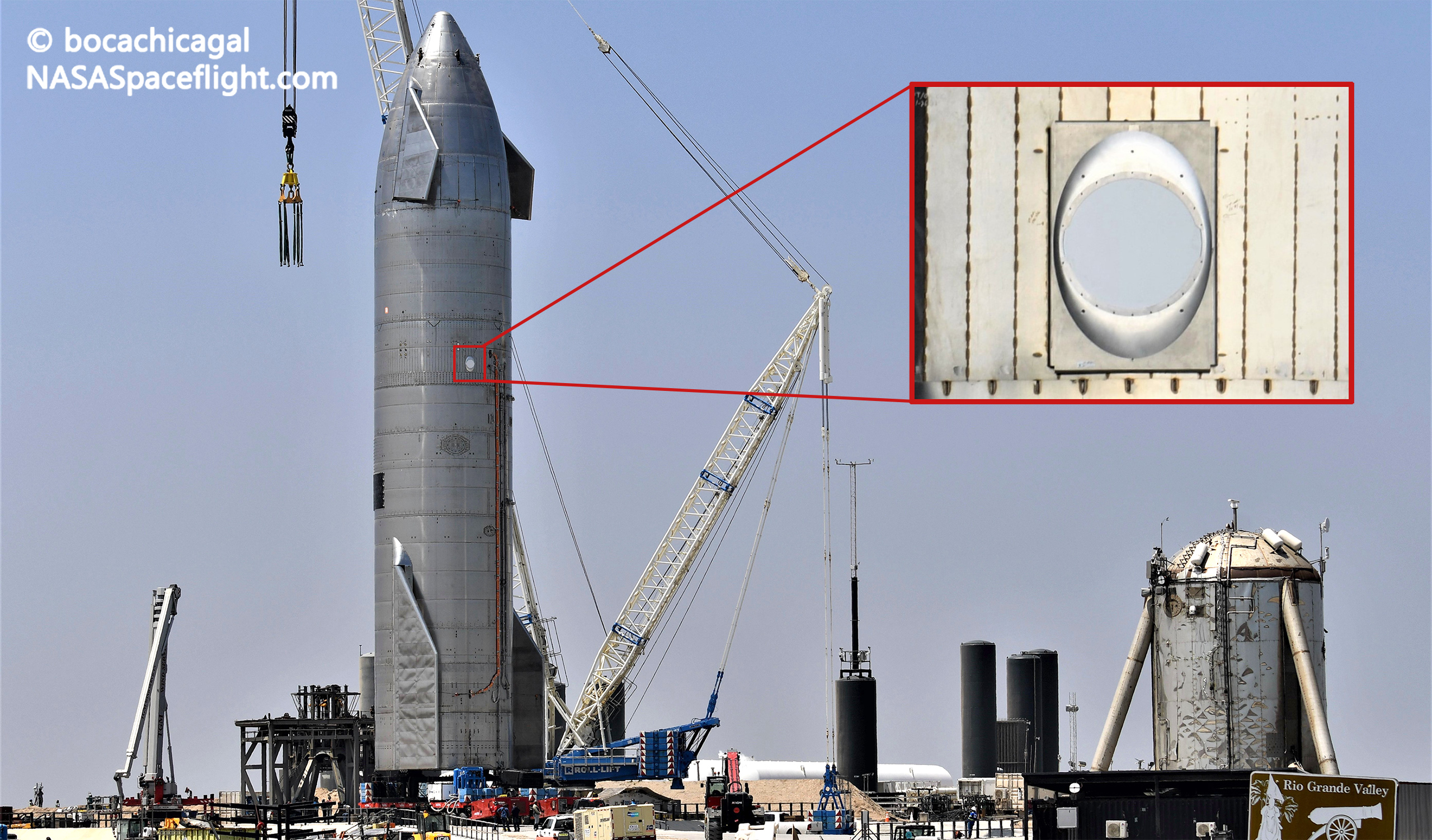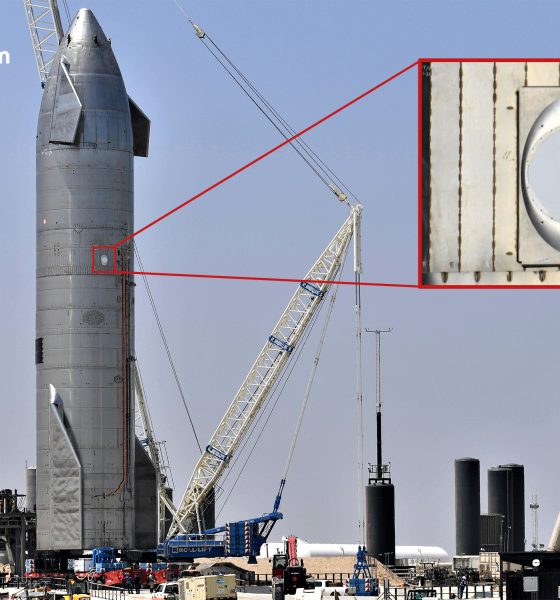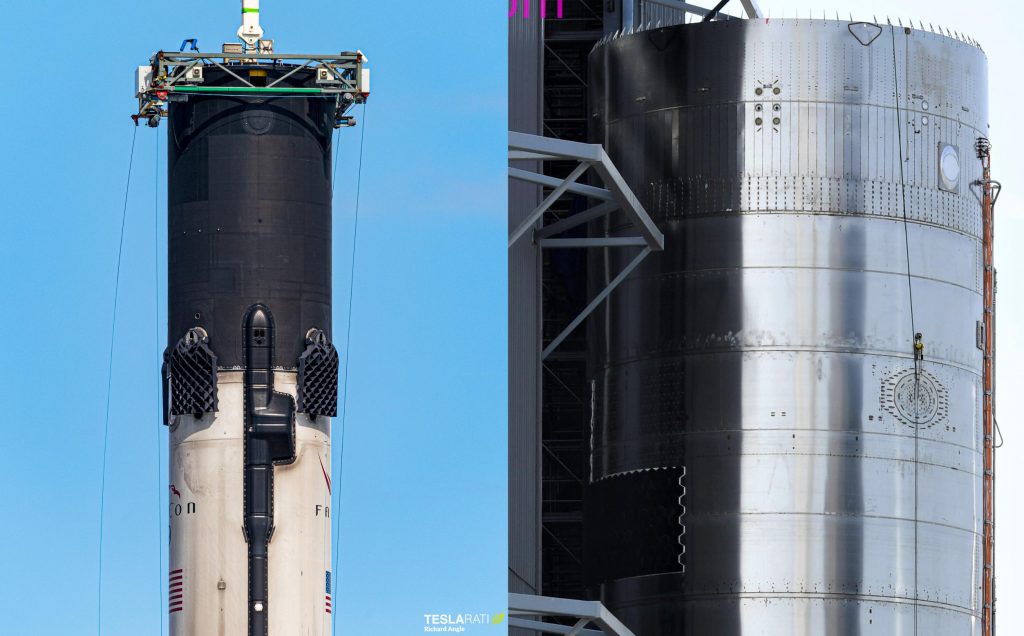

News
SpaceX says Starship can beat ‘plasma blackout’ with Starlink antennas
SpaceX has asked the FCC to allow Starship and its Super Heavy booster to communicate with Starlink during the rocket’s first orbital launch attempt, potentially unlocking game-changing capabilities.
Filed on June 28th, SpaceX’s Special Temporary Authority (STA) application contains a number of surprising details about the company’s plans to expand the experimental use of its Starlink satellite constellation to communicate with rockets in flight. That effort was first made public in April 2021 when a separate FCC application revealed plans to test Starlink on a Starship prototype. Starship serial number 15 (now known as Ship 15 or S15).
That particular prototype became the first of its kind to successfully launch and land in one piece on May 5th. Nothing is known about whether Starlink was actually used or how the Starship’s lone dish performed during the 10 kilometer (6.2 mi) flight test, but SpaceX’s plans to again combine both two Star– programs do offer some new lines to read between.
Relative to its first Starlink-Starship STA application, SpaceX splits no hairs in the ‘narrative’ attached to its latest request. Specifically, SpaceX repeatedly discusses the potential for Starlink to drastically improve the state of the art of routine spacecraft and launch vehicle telemetry and communications.
“SpaceX intends demonstrate high data rate communications with Starship and the Super Heavy Booster on the ground at the launch site in Starbase, TX during launch, during booster recovery, in flight, and during reentry. Starlink can provide unprecedented volumes of telemetry and enable communications during atmospheric reentry when ionized plasma around the spacecraft inhibits conventional telemetry frequencies. These tests will demonstrate Starlink’s ability to improve the efficiency and safety of future orbital spaceflight missions.“
SpaceX — June 28th, 2021
In short, in the two months since SpaceX first requested permission “to operate a single user terminal…during flight tests,” the company appears to have become extremely bullish about Starlink’s potential as a solution for rocket communications. The logical conclusion is that Starlink performed well during its trials aboard Starship S15 on the ground and in flight – possibly even exceeding SpaceX’s own expectations. Simultaneously, SpaceX is in the midst of expanding efforts to certify Starlink for aviation communications and has been generally ramping up tests on aircraft, ships, and road vehicles.
Indeed, at least in theory, the same attributes that allow Starlink to blow traditional consumer satellite communications solutions out of the water could make Starlink a boon for launch vehicle communications. That’s especially true for the test flights of experimental launch vehicles like Starship, where failure is an inevitable part of the development process. However, those launch failures are only beneficial insofar as they expand the knowledge base and allow lessons to be learned.

Data, in other words, is essential, and the more data recovered from test flights, the better. Even on modern rockets, state-of-the-art telemetry usually involves maximum bandwidth on the order of a few hundred to a few thousand kilobits per second, often requiring software and compression gymnastics and uncomfortable triage to ensure that all necessary telemetry keeps flowing.
If Starlink could expand that bandwidth from a few megabits per second (Mbps) to dozens or even hundreds of Mbps, SpaceX could extract unprecedentedly widespread and high-resolution telemetry from Starship and Super Heavy during their first orbital test flight, leaving a wealth of data for likely post-flight failure analyses.

Perhaps most surprising is SpaceX’s claim that Starlink antennas could allow Starship to maintain a strong communications link throughout orbital reentry. Traditionally, all spacecraft capable of reentry produce a superheated sheath of plasma as they careen into Earth’s upper atmosphere. That plasma effectively blocks most radio waves, creating an inevitable several-minute communications ‘blackout’ for any reentering spacecraft.
If Starlink can somehow allow SpaceX to break through that ‘plasma barrier,’ it would give the company an unprecedented capability invaluable for the process of perfecting orbital Starship reentry, descent, and landing – a process Musk expects to involve several unsuccessful attempts. According to SpaceX’s FCC application, Starship’s first orbital launch and reentry attempt could occur as early as August 2021.

News
Tesla starts showing how FSD will change lives in Europe
Local officials tested the system on narrow country roads and were impressed by FSD’s smooth, human-like driving, with some calling the service a game-changer for everyday life in areas that are far from urban centers.

Tesla has launched Europe’s first public shuttle service using Full Self-Driving (Supervised) in the rural Eifelkreis Bitburg-Prüm region of Germany, demonstrating how the technology can restore independence and mobility for people who struggle with limited transport options.
Local officials tested the system on narrow country roads and were impressed by FSD’s smooth, human-like driving, with some calling the service a game-changer for everyday life in areas that are far from urban centers.
Officials see real impact on rural residents
Arzfeld Mayor Johannes Kuhl and District Administrator Andreas Kruppert personally tested the Tesla shuttle service. This allowed them to see just how well FSD navigated winding lanes and rural roads confidently. Kruppert said, “Autonomous driving sounds like science fiction to many, but we simply see here that it works totally well in rural regions too.” Kuhl, for his part, also noted that FSD “feels like a very experienced driver.”
The pilot complements the area’s “Citizen Bus” program, which provides on-demand rides for elderly residents who can no longer drive themselves. Tesla Europe shared a video of a demonstration of the service, highlighting how FSD gives people their freedom back, even in places where public transport is not as prevalent.
What the Ministry for Economic Affairs and Transport says
Rhineland-Palatinate’s Minister Daniela Schmitt supported the project, praising the collaboration that made this “first of its kind in Europe” possible. As per the ministry, the rural rollout for the service shows FSD’s potential beyond major cities, and it delivers tangible benefits like grocery runs, doctor visits, and social connections for isolated residents.
“Reliable and flexible mobility is especially vital in rural areas. With the launch of a shuttle service using self-driving vehicles (FSD supervised) by Tesla in the Eifelkreis Bitburg-Prüm, an innovative pilot project is now getting underway that complements local community bus services. It is the first project of its kind in Europe.
“The result is a real gain for rural mobility: greater accessibility, more flexibility and tangible benefits for everyday life. A strong signal for innovation, cooperation and future-oriented mobility beyond urban centers,” the ministry wrote in a LinkedIn post.
News
Tesla China quietly posts Robotaxi-related job listing
Tesla China is currently seeking a Low Voltage Electrical Engineer to work on circuit board design for the company’s autonomous vehicles.

Tesla has posted a new job listing in Shanghai explicitly tied to its Robotaxi program, fueling speculation that the company is preparing to launch its dedicated autonomous ride-hailing service in China.
As noted in the listing, Tesla China is currently seeking a Low Voltage Electrical Engineer to work on circuit board design for the company’s autonomous vehicles.
Robotaxi-specific role
The listing, which was shared on social media platform X by industry watcher @tslaming, suggested that Tesla China is looking to fill the role urgently. The job listing itself specifically mentions that the person hired for the role will be working on the Low Voltage Hardware team, which would design the circuit boards that would serve as the nervous system of the Robotaxi.
Key tasks for the role, as indicated in the job listing, include collaboration with PCB layout, firmware, mechanical, program management, and validation teams, among other responsibilities. The role is based in Shanghai.
China Robotaxi launch
China represents a massive potential market for robotaxis, with its dense urban centers and supportive policies in select cities. Tesla has limited permission to roll out FSD in the country, though despite this, its vehicles have been hailed as among the best in the market when it comes to autonomous features. So far, at least, it appears that China supports Tesla’s FSD and Robotaxi rollout.
This was hinted at in November, when Tesla brought the Cybercab to the 8th China International Import Expo (CIIE) in Shanghai, marking the first time that the autonomous two-seater was brought to the Asia-Pacific region. The vehicle, despite not having a release date in China, received a significant amount of interest among the event’s attendees.
Elon Musk
Elon Musk and Tesla AI Director share insights after empty driver seat Robotaxi rides
The executives’ unoccupied tests hint at the rapid progress of Tesla’s unsupervised Robotaxi efforts.

Tesla CEO Elon Musk and AI Director Ashok Elluswamy celebrated Christmas Eve by sharing personal experiences with Robotaxi vehicles that had no safety monitor or occupant in the driver’s seat. Musk described the system’s “perfect driving” around Austin, while Elluswamy posted video from the back seat, calling it “an amazing experience.”
The executives’ unoccupied tests hint at the rapid progress of Tesla’s unsupervised Robotaxi efforts.
Elon and Ashok’s firsthand Robotaxi insights
Prior to Musk and the Tesla AI Director’s posts, sightings of unmanned Teslas navigating public roads were widely shared on social media. One such vehicle was spotted in Austin, Texas, which Elon Musk acknowleged by stating that “Testing is underway with no occupants in the car.”
Based on his Christmas Eve post, Musk seemed to have tested an unmanned Tesla himself. “A Tesla with no safety monitor in the car and me sitting in the passenger seat took me all around Austin on Sunday with perfect driving,” Musk wrote in his post.
Elluswamy responded with a 2-minute video showing himself in the rear of an unmanned Tesla. The video featured the vehicle’s empty front seats, as well as its smooth handling through real-world traffic. He captioned his video with the words, “It’s an amazing experience!”
Towards Unsupervised operations
During an xAI Hackathon earlier this month, Elon Musk mentioned that Tesla owed be removing Safety Monitors from its Robotaxis in Austin in just three weeks. “Unsupervised is pretty much solved at this point. So there will be Tesla Robotaxis operating in Austin with no one in them. Not even anyone in the passenger seat in about three weeks,” he said. Musk echoed similar estimates at the 2025 Annual Shareholder Meeting and the Q3 2025 earnings call.
Considering the insights that were posted Musk and Elluswamy, it does appear that Tesla is working hard towards operating its Robotaxis with no safety monitors. This is quite impressive considering that the service was launched just earlier this year.








